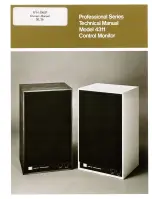
7700 MultiFrame Manual
7707DT RS-232/422/485 Fiber Data Transceiver
Revision
1.8
Page - 31
7.3.
TERMINATION AND FAILSAFE BIAS
If signal cable lengths are kept to a minimum, then the above interface methods should work without any
requirement for terminations or failsafe bias. The 7707DT does provide selectable input terminations and
failsafe bias when required.
Signal terminations are used to eliminate distortion of signals traveling over long lengths of cable. If
problems are experienced, and signal distortion is suspected, then the user should enable the input
termination of the respective 7707DT. Input terminations are easily selectable through the card edge
interface of the 7707DT, or via
Vista
LINK
®
, as described in the product manual. As a general rule,
terminations are most effective when placed at the far end of a cable. If more than two devices are
connected to the same cable, as could be the case with MPK interfaces, then it is recommended that the
7707DT be located at the far end of the longest cable segment when possible.
The 7707DT also provides a selectable bias on the balance data inputs. This is referred to as a failsafe
bias, as it places the balanced input connections in a known logic state while no device is transmitting to
them. Any direct connection between a 7707DT input and a Control Panel may require a failsafe bias, to
compensate for ambient noise, long lengths of cable, or connection to many devices. Input failsafe bias is
easily selectable through the card edge interface of the 7707DT, or via
Vista
LINK
®
, as described in the
product manual. To enable failsafe bias on any channel of the 7707DT, the termination must first be
enabled.


































